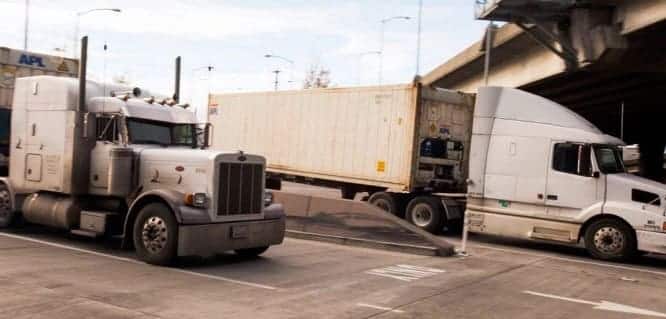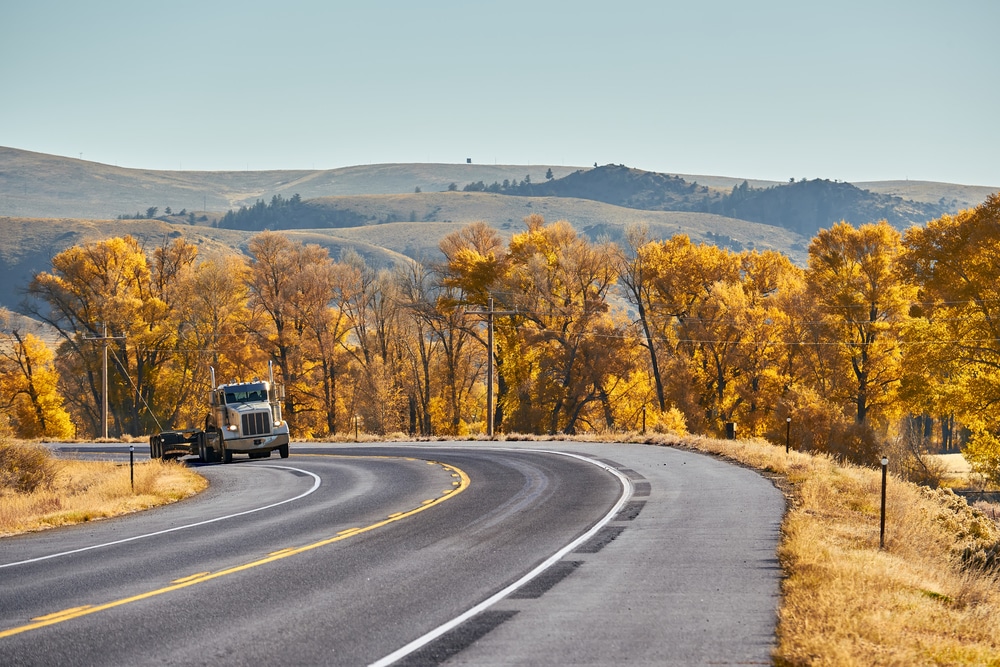With more than 4700 fatalities every year, collisions that involve large vehicles like log trucks can leave dozens of devastated victims in their wake. As a fellow driver, it’s important to understand how log truck accidents occur and what to do in order to be prepared for the worst-case scenario.
Have you or a loved one been involved in a log truck accident? If the answer is yes, having an experienced attorney by your side will allow you to focus on making a full recovery while ensuring that you get the compensation required to cover these expenses.
Let’s take a look at what log trucks do, how log truck accidents occur, and why this type of collision is so dangerous. We will also mention common damages that victims experience during these accidents, regulations surrounding these crashes, and what to do if you were involved in a log truck collision.
What Does a Log Truck Do?
As the name suggests, log trucks play a crucial role in our society because they transport timber to factories and plants for processing.
Log truck routes exist throughout the country, but they are particularly common in the Pacific Northwest and the entire West Coast. While most trucks never experience any trouble, one single crash can produce millions of property damages as well as extensive injuries and even loss of life.
How Do Logging Truck Accidents Happen?
Logging truck accidents are relatively uncommon. However, because they have the potential to cause a huge amount of damage, it’s important for all drivers to be careful and for lawmakers to implement regulations that keep this type of collision to a minimum.
Here are some common reasons why trucking accidents can occur.
Overloaded Trucks and Improper Securing
Every log truck has a weight as well as volume limit, and as long as these are followed then the chances of an accident remain relatively low.
But, in some cases, loggers may accidentally overload their trucks or use improper securing methods due to the excessive volume, which can imbalance the logs and cause a huge crash later on.
Tired Drivers or a Lack of Experience
While there are laws and regulations that help prevent drivers from getting fatigued, it’s important to understand that driving a logging truck is a tiring experience.
Even if the company and driver adhere to all regulations, it’s still possible to see a log truck wreck due to tiredness or fatigue.
Poor Fleet Maintenance
The maintenance of the fleet is often the responsibility of the trucking company, although this can also be outsourced to another provider.
Nevertheless, if the vehicle fleet has old tires, engines that aren’t checked properly, and other issues, the chances of an accident increase exponentially.
Speeding and Weather Conditions
Last but not least, speeding and bad weather conditions can both increase the chances of an accident, especially if they occur at the same time.
Drivers often feel the need to drive past the speed limit when they are subjected to unreasonable schedules. If the truck you crashed with was speeding, it may be a split responsibility between the driver and the trucking company.
Likewise, inclement weather like snow and rain can cause wheels to skid and slide, which can result in a truly catastrophic highway crash.
Why Logging Truck Accidents Are So Dangerous
The reason why a logging truck crash can be so devastating is that it often occurs on the highway, at high speeds, and involves a huge vehicle. If an accident is so severe that the logging truck flips or the logs are released, the damage and injuries that these can produce are also extremely gruesome.
This is the reason why every accident victim should seek professional help and ensure that they have everything needed to make a full recovery.
Damages Available After a Collision with a Logging Truck
Log truck crash victims usually experience a combination of physical injuries and property damages. This list can include:
- Extensive personal injuries or wrongful death
- Emotional and psychological trauma
- Large-scale property damage
- Loss of the ability to work
- Medical expenses
Regulatory Measures and Safety Standards that Affect Log Truck Accidents
The Federal Motor Carrier Safety Administration (FMCSA) has released a set of regulations that help minimize logging truck accident rates.
These include:
- Hours of Service limits that dictate how much rest drivers need
- Vehicle maintenance requirements for logging trucks
- Only drivers with a commercial driver’s license can operate logging trucks
Besides that, there are also load management rules that reduce the chances of logging truck accidents. This protocol includes guidelines on the type of fasteners that need to be used as well as speed limits related to size and weight.
What to Do If You Have Been Involved in a Crash with a Logging Truck
Log truck wrecks can be deadly, so you have to be very careful and seek help as soon as these occur.
If you are involved in a logging truck accident, you should:
- Seek medical attention right away
- If possible, collect contact information from the driver as well as witnesses
- Document the event by taking pictures of the vehicles and road
- Contact your insurance provider
- Call your log truck accident attorney to start building your case.
Finding a Log Truck Accident Attorney You Can Trust
Log truck crashes are devastating because they can produce an enormous amount of property damage and physical harm in a matter of seconds.
If you or a loved one has been involved in one of these collisions there’s a strong chance you have significant injuries that require medical attention. You shouldn’t have to face this alone, the party responsible for the accident should be held accountable for your damages. Which, in turn, can give you the time, space, and funds you need to bounce back.
At Coluccio Law, we’ve helped log truck accident victims in the past, so we understand what these victims need to overcome their injuries. Contact us today to learn more about filing a claim and getting fairly compensated for your log truck accident injuries.
How a Log Truck Crash Killed 2 Scientists and Made us Safer – A Case Study
Many years ago, I represented Anthony Qamar’s family after he was killed in a log truck crash.
I often think of the families and people I have represented over my three decades as an attorney. Tony’s case came to mind recently when I was asked to represent a man who was seriously injured when the driver of a log truck pulled out right in front of him.
The log truck crash that (finally) changed the law
Tony was a Washington State seismologist, and a research professor at the University of Washington. He, along with Daniel J. Johnson, a former University of Puget Sound geophysics researcher, were driving to the Olympic Peninsula to check on instruments and collect recent earthquake data off the coast.
As the scientists were traveling down U.S. 101, an overloaded log truck dumped its load. The result was a horrific crash that fatally injured both Tony and Dan.
In investigating the log truck crash, we learned some bone-chilling facts.
- The truck driver was speeding.
- The log trailer had been overloaded.
- The truck driver had a history of safety problems; and,
- He had tested positive for methamphetamines.
Finally, shortly after the fatal crash, the trucker—who had emerged unscathed from the fatal wreck—was back on the highway. He was driving logging rigs for a company with a long history of safety violations.
Within months, he spilled another load of logs.

After a two-year effort by the scientists surviving families and friends, the Tony Qamar and Daniel Johnson Act was signed into law in Washington State, creating a new system to remove dangerous commercial vehicles from public highways.
The new law gave the Washington State Patrol (WSP) speedy access to statewide date that allows for inspection and compliance reviews to focus on higher-risk carriers. Specifically, the new law made the following changes.
- Required intrastate (within the state) motor carriers that operate trucks over 26,000 pounds—or trucks that carry hazardous materials, like very heavy logs—to get a USDOT number. Now their safety violations are recorded in the existing federal safety database that was set up for interstate trucking.
- Authorizes the Washington State Patrol to prioritize for inspection and compliance reviews the motor carriers that have been identified as higher risk carriers. WSP can shut down trucking companies with a pattern of safety violations until the violations are corrected.
- Significantly increased penalties for multiple violations.
One case can make a difference.
I was honored to represent the Qamar family in bringing accountability and responsibility for Tony’s death. Our legal team obtained insurance policy limits to resolve the liability claims. But, like most families, they needed more than financial restitution.
In this case, the changes to the law were a fitting tribute to two people who had spent their lives using facts and data to promote public safety.
The new log truck crash case I am handling doesn’t have the same serious safety issues. In fact, I have never seen another logging truck case as egregious as the Qamar case.
That is not an accident. It is a direct result of the enactment of the Qamar and Johnson law, which has prevented similar crashes from occurring throughout the state of Washington.
Truck crash case: Qamar v. Leonard Trucking, Inc.; $1,850,000.00 (maximum result – policy limits).



